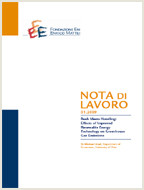Going Forward by Looking Backwards on the Environmental Kuznets Curve: an Analysis of CFCs, CO2 and the Montreal and Kyoto Protocols

03.09.2014
Thomas Longden
Q5, Q50, Q58
Environmental Kuznets Curve, Montreal Protocol, Kyoto Protocol
Climate Change and Sustainable Development
Carlo Carraro
The success of the Montreal Protocol in comparison to the stagnation seen in negotiations surrounding the Kyoto Protocol highlights the importance of: – a supportive industry group, – pre-existing legislation and commitment by a lead nation, – affordable and available substitutes, as well as – acceptance of the underlying scientific explanation of the link between emissions and a key detrimental impact. The focus on these contrasting intergovernmental agreements within this paper is driven, in part, by the intention to establish that successful emission reductions tend to be associated with a concerted policy effort rather than the level of per capita income. This is in contrast to the concept of the Environmental Kuznets Curve (EKC) which contends that a significant negative relationship exists between high levels of national income and per capita emissions. While a nation’s level of development and national income are likely to be linked to an ability to make structural changes and/or the implementation of environmental policy, this paper finds no evidence of an EKC consistent negative quadratic relationship between income and CFC emissions once key considerations, such as biased estimations and policy effort, have been accounted for.
***
Suggested citation: Longden, T., (2014), ‘ Going Forward by Looking Backwards on the Environmental Kuznets Curve: an Analysis of CFCs, CO2 and the Montreal and Kyoto Protocols’, Nota di Lavoro 74.2014, Milan, Italy: Fondazione Eni Enrico Mattei.
